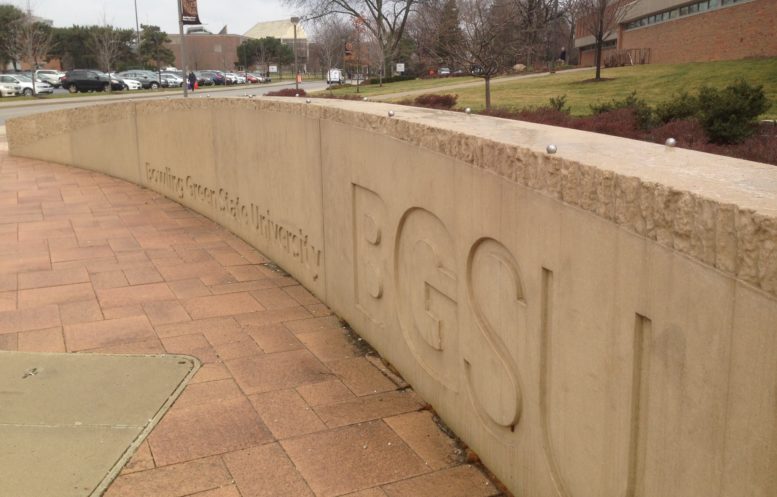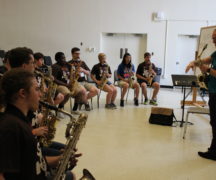By DAVID DUPONT
BG Independent News
The tentative three-year contract between Bowling Green State University and the BGSU Faculty Association will get scrutiny from union members this week. Forums are scheduled for both the Bowling Green and the Firelands campuses.
Then next week, union members will vote on whether to ratify the pact. The faculty association represents all 711 faculty, both tenure track and non-tenure track, on campus. Only association members get to vote. If approved, the contract will be considered by the Board of Trustees at its May 6 meeting.
David Jackson, the union’s president since it was formed in 2010, believes the contract should be ratified. “It’s a very good contract and I’m strongly encouraging people to vote for it.”
The pact represents a breakthrough for the union, not just because of what’s in its 210-plus pages, but because of the way it was achieved, and the good will the process engendered.
The previous union negotiations were “combative” at times and interrupted by an effort by the administration of Gov. John Kasich to eliminate state employee unions. The first contract took 22 months to reach and was finally agreed on in March, 2013.
This time negotiations began in earnest this fall and with the tentative pact reached in late March. “The whole process has been so much more collaborative and collegial than it was last time,” Jackson said.
BGSU President Mary Ellen Mazey echoed those sentiments in a statement released by the Office of Marketing and Communications. “We are extremely pleased, both with the collegiality of the process and the outcome. The agreement lays the foundation for closer collaboration with our faculty which will strengthen our University and help us continue to meet the needs of our students.”
While much credit has been given to the sides using Interest-Based Bargaining in the negotiations, the groundwork was actually laid during the three years since the last agreement.
Jackson said that the Federal Mediation and Conciliation Service evaluated the situation to assess whether Interest-Based Bargaining would work.
“Over the last few years the administration and faculty association has worked very hard to develop a level of trust,” he said. “President Mazey and I have developed a good relationship.”
In the three years under the first union contract, Jackson said, “most of what we’ve done … has been discipline and grievance cases. … That’s what made the relationship better – working through these discipline and grievance cases and coming up with fair solutions. They’ve seen we don’t take frivolous cases, and we try to settle cases in a fair way.”
Once the federal council approved the use the system at BGSU, the two negotiating teams went through training over the summer before bargaining started in fall. Both named lead negotiators Stephen Demuth, a professor of sociology, for the BGSU-FA and Bill Balzer, vice president for faculty affairs and strategic initiatives, for the university. Jackson both sides did a good job selecting leaders and members of their negotiating teams. “I’m outrageously impressed by the hard work those teams did and how fast we got there.”
Interest-Based Bargaining differs in essential ways from traditional bargaining. For example, what is said in the sessions stays in the room. This allows, Jackson said, both sides to float ideas more freely. But it also means, he said, that now that the two sides have reached agreement, the union has more education to do about what’s in the contract.
Also, all members of the negotiating teams must agree on all issues, and issues are settled independently of others. Proposals can be made without being presented as a formal offer. All members of the negotiating teams actively participate in the bargaining, not just the lead negotiators.
The process worked well enough, Jackson said, that they even used it to negotiate compensation, which is sometimes set aside and negotiated in the traditional way.
The result was a 3-percent increase in each of the three years of the contract, which takes effect July 1. Health care premiums will stay the same. Often, Jackson said, when a union gets a pay raise, it ends up giving back those gains in other ways, especially health care. That is not the case here, aside from a small increase in the cost of parking.
The contract continues to fine tune the disciplinary and grievance policies first put in place in the last contract. Much of what’s in the contract furthers the work started in that first agreement. A number of committees will be formed to address specific issues. Jackson ruefully noted only academics would see the creation of committees as a sign of progress. But those committees are needed to further the level of cooperation between the faculty and administration. And they provide a wealth of opportunities for faculty to volunteer and participate in the process, he said.
The contract addresses several issues that arose two years ago when dozens of non-tenure track faculty members were laid off. Now the administration will have to give more senior NTTF more advance notice if they are going to be let go, and those faculty will face less frequent and less “intrusive” evaluations.
This gives the 234 non-tenure track faculty more job security though not as much as afforded by tenure, Jackson said. With enrollment “moving in the right direction,” he doesn’t expect those provisions regarding layoffs to be needed.
Looking forward, he added, “we need to think about these different tracks and consider a way to have teaching professors get tenure as well.”
The contract also includes schedule of monetary incentives for faculty members who bring in outside funding.
The contract, Jackson said, provides a measure of stability for the university because it knows what its faculty salary costs will be in the next three years.
The faculty association will now use this contract as a recruitment tool. When the faculty association first was considered, many had serious questions, Jackson said. One, in fact, was future lead negotiator Demuth.
The association tries to be open and transparent. Still there are “scars” left from earlier debates, Jackson said. “People think there’s a war going on between us and the administration, but there isn’t,” he said. “This is much more collaborative era.”





